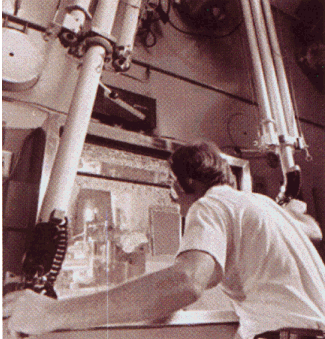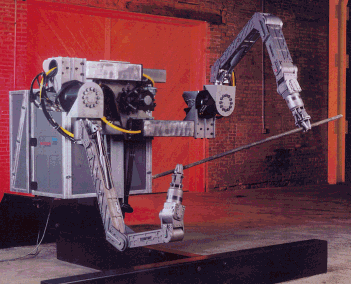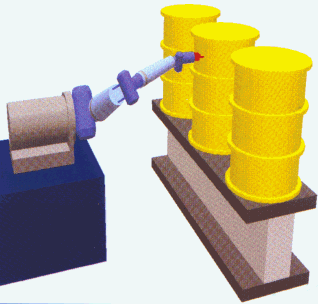|
|
Robots in Radioactive Environments
Or as President Bush liked to say
"Nookuler"
|
 |
The folks working on the first atomic
bombs pretty much defined telerobotics in this country.
They had no other way of working with the radioactive
materials. They used pure mechanical coupling for their
telerobotics. The operator would stand on one side of a
thick, leaded glass window while the robot manipulated
the material on the other side. Cables, bands and tubes
provided the coupling. Before long, these systems were
carefully engineered with counter balancing and very low
friction surfaces. The mechanical coupling provided
natural force feedback. I had the opportunity to use one
of these systems at Oak Ridge National Lab and it was far superior to any modern, motorized,
electronic telerobotic system I have tried (and I have
tried very many of them). I would recommend the use of
these manual systems in any telerobotic application
where it is not necessary to project the control beyond
the next room. |
|
|
|
The robot at right was developed for
the decontamination and dismantlement of nuclear weapons
facilities. It has two six-degree of freedom Schilling
arms mounted on a five-degree of freedom base. As the
facilities used to develop our country's nuclear weapons
enter their 50th year and beyond, we now have to
dismantle them and safely store the
waste. The radioactive fields makes this activity too
hazardous for human workers so the use of robotics makes
sense. The idea for this robot is that it can hold a
part in one hand and use a cutting tool with the other;
basically stripping apart the reactor layer by layer
(something like peeling an onion). As the robot works it
too will become contaminated and radioactive and
ultimately need to be stored as radioactive waste. |

|
|
|
 |
The graphic at left is a conceptual
depiction of a robot arm mounted on a mobile base
checking drums filled with radioactive waste for leaks.
The question of what to do with our radioactive waste is
a hotly debated topic. The idea of storing it in
warehouses and monitoring it with robots for the next
100,000 years (if necessary) makes sense to me. We might
as well admit we have it, monitor it logically and hope
that future generations will figure out something to do
with it; perhaps re-reacting it into a less dangerous
state. Another proposed alternative is to bury it;
which to me seems insane. Over the course of centuries
it is bound to leak from its containers and ultimately
into the ground water. Because it would be buried and
almost impossible to monitor, we would not know about
the contamination until the damage was huge, and then it
would be extremely difficult to get at because it was
buried. Another proposal is to use space craft and
launch the material into the Sun. Who thinks of these
things? Please don't mess with the Sun! |
|
|
|